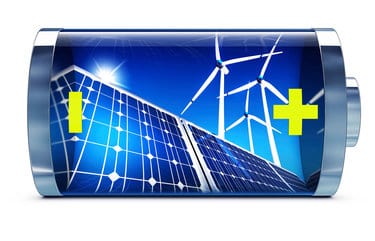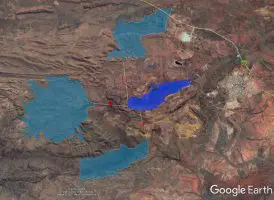 Energy minister Josh Frydenberg has sought to clarify recent comments on the storage requirements for new wind and solar farms, saying it would be up to the Australian Energy Market Operator to decide how much is needed.
Energy minister Josh Frydenberg has sought to clarify recent comments on the storage requirements for new wind and solar farms, saying it would be up to the Australian Energy Market Operator to decide how much is needed.
Recent examples used by Frydenberg – one in the party room and another at a recent conference – had raised concerns that all new wind and solar farms would be burdened by excessive amounts of storage requiremens.
However, Frydenberg told RenewEconomy on Thursday that recent examples he had used – of a 100MW wind farm having 25MW storage for four hours, or 50MW for two hours – were only a guide.
“As I have said publicly on numerous occasions the Turnbull government welcomes Finkel’s recommendation that intermittent sources of generation be responsible for supplying their own storage and that the storage requirements may depending on need vary from state to state,” he said.
“It is appropriate that the quantity of that storage requirement be determined by AEMO as they are best placed to assess what storage levels are needed to stabilise the grid.
“As an illustration it has been suggested that a storage requirement of 25 per cent of nameplate capacity for 4 hours may be a guide, but again the actual requirement needs to be set by AEMO.”
Frydenberg was also anxious to dispel the suggestion that he was seeking to turn wind and solar into “baseload” plants because that would presuppose being able to generate at full capacity 24/7 – which is not what he is proposing.
Frydenberg’s commitment to leave the issue with AEMO are important as policy makers and energy market authorities wrestle with the shift in energy market design.
It is now clear that the system will shift from the old baseload/peakload paradigm to one based predominantly around the cheapest cost of energy – which is now wind and solar – and having dispatchable and reliable generation filling in the gaps, and how to manage that transition as coal plants exit the system.
That shift reached another major pivot point last week when South Australia announced that Tesla would build a 100MW/129MWh lithium-ion battery storage – the world’s biggest – near the 309MW Hornsdale wind farm owned by Neoen.
It is the first big initiative towards making wind and solar “dispatchable”, even though much of the capacity of that particular Tesla plant will be dedicated to ensuring the stability of the grid in the event of faults such as a network failure or a big gas plant tripping.
Indeed, 70MW of the Tesla facility will only be able to operate at full capacity for around 10 minutes. But that is all that is needed in fast response to network and other faults. But the short time-frame of the storage is causing confusion among many about the role and capacity of the plant. (See our explainer here).
How to manage that transition and integrate storage of various types and designs is the key question for operators and policy makers.
Conservatives have been calling for new coal fired power stations to be built, digging deeper into the baseload thinking, despite all private players in the industry saying they would never be interested in such investments because of their cost and emissions.
Frydenberg has written to AEMO asking what level of storage will be needed when the Liddell and Vales Point coal generators close as planned in NSW in the 2020s.
AEMO is also looking at how much storage will be needed as the penetration levels of wind and solar approach and move beyond what the CSIRO and Energy Networks Australia describe as “trivial” levels of penetration – between 30 and 50 per cent.
Both it and the Australian Energy Market Commission have numerous studies under way, and it is likely to be a fluid and on-going work, given the rapidly evolving industry views about how much wind and solar can be incorporated into the grid, how much “real inertia” is needed and what machinery can provide other critical network services.
AEMO boss Audrey Zibelman wants the new investments to be market driven as much as it can. She has expressed caution about the amount of storage needed over the long term, although AEMO’s biggest concerns appear to be the next two summers and the reliability of the country’s ageing fossil fuel fleet.
She is also advocating the use of “smart” demand side technologies such as “demand management”, energy efficiency and battery storage, and wants the state and federal ministers to “get on with it” to push through the Finkel recommendations and new market rules.
Some wind and solar farms are going to add battery storage in any case, because they see market value in shifting their output from low to high demand and/or providing grid security services like synthetic inertia or frequency and voltage control.
In many cases, battery storage will be used to deflect investments in new poles and wires and equipment upgrades.
Battery storage is considered the best value now for instant response and short term storage, while longer term storage may be best served by pumped hydro and other storage technologies such as solar thermal.
The question is that if Snowy Hydro 2.0 and the proposed Tassie Hydro expansion are built, how much other large scale storage will be needed.
The question might then be whether those facilities can make sufficient revenue from their normal course of operations, or whether it would need wind and solar plants to “subscribe” to their services.
The Finkel Review made clear that the cost of solar and wind, plus storage or firming capacity, is cheaper than gas and no more expensive than coal, even if carbon emission and other environmental costs are not counted.
Other studies by AGL, Reputex, the ANU and others have come to similar conclusions. The key, however, will likely be in the market design, which suits incumbents at the moment because it did not contemplate the arrival of zero-fuel cost technologies like wind and solar, and the arrival of storage.
The much-delayed 5-minute rule, which will encourage battery storage over slow moving gas plants, will be a key component.
The NSW Coalition government has said that Snowy Hydro 2.0 would enable 5GW of new wind and solar to be built. It hopes to build two big “renewable energy spines” going east west and north south across the state, taking advantage of local resources and infrastructure.
Queensland, which has very little large scale wind and solar construction, although about 2,000Mw in construction or about to start, is about to hold a tender for energy storage.
It already has the little-used Wivenhoe pumped storage facility and Genex, which is proposing a 250MW pumped hydro plant next to a 270MW solar farm on the old Kinston gold mine, has made the short-lift for financing from the North Australian Infrastructure Fund.
Any new wind farms in Tasmania would not need new storage because it already has so much pumped hydro facilities.










